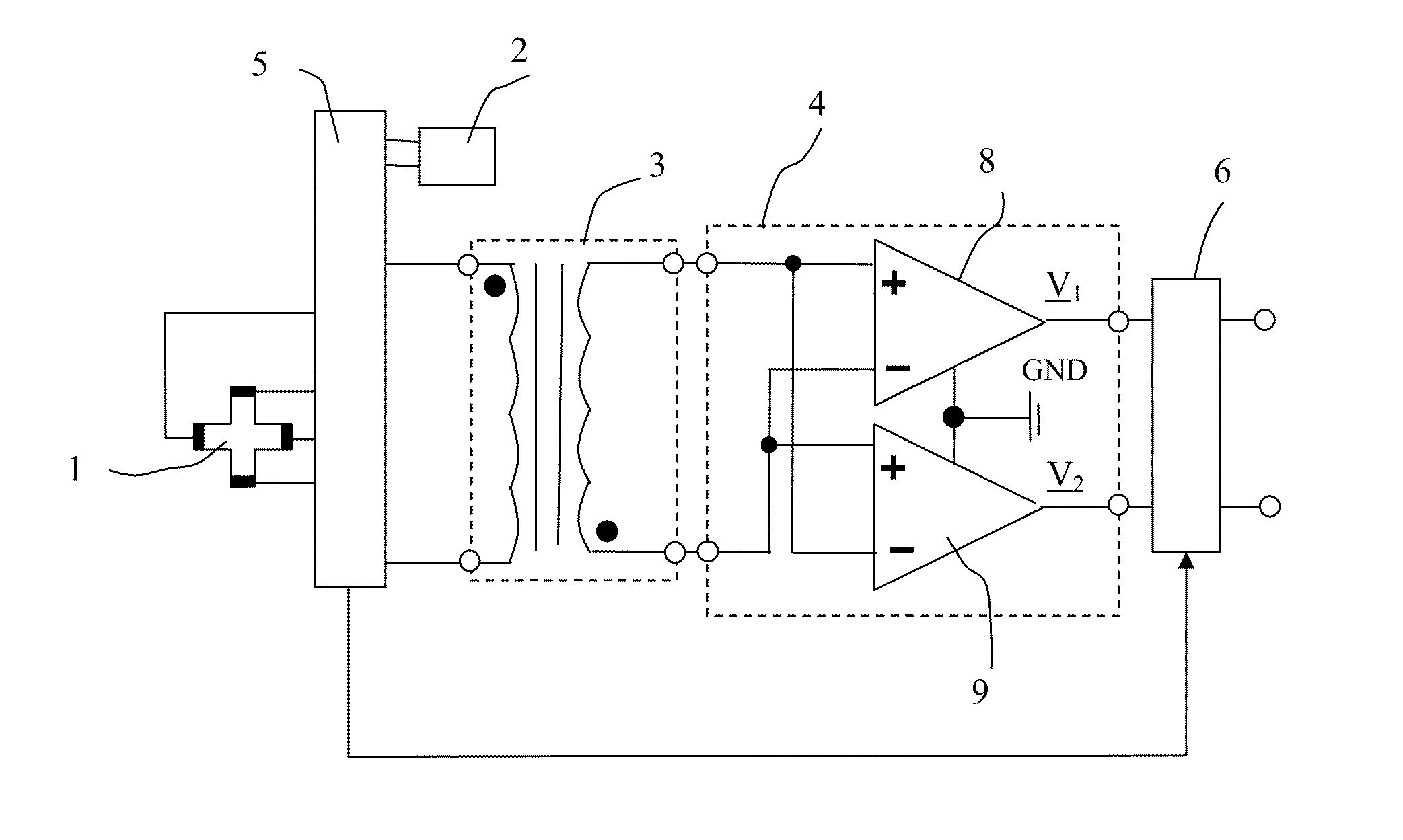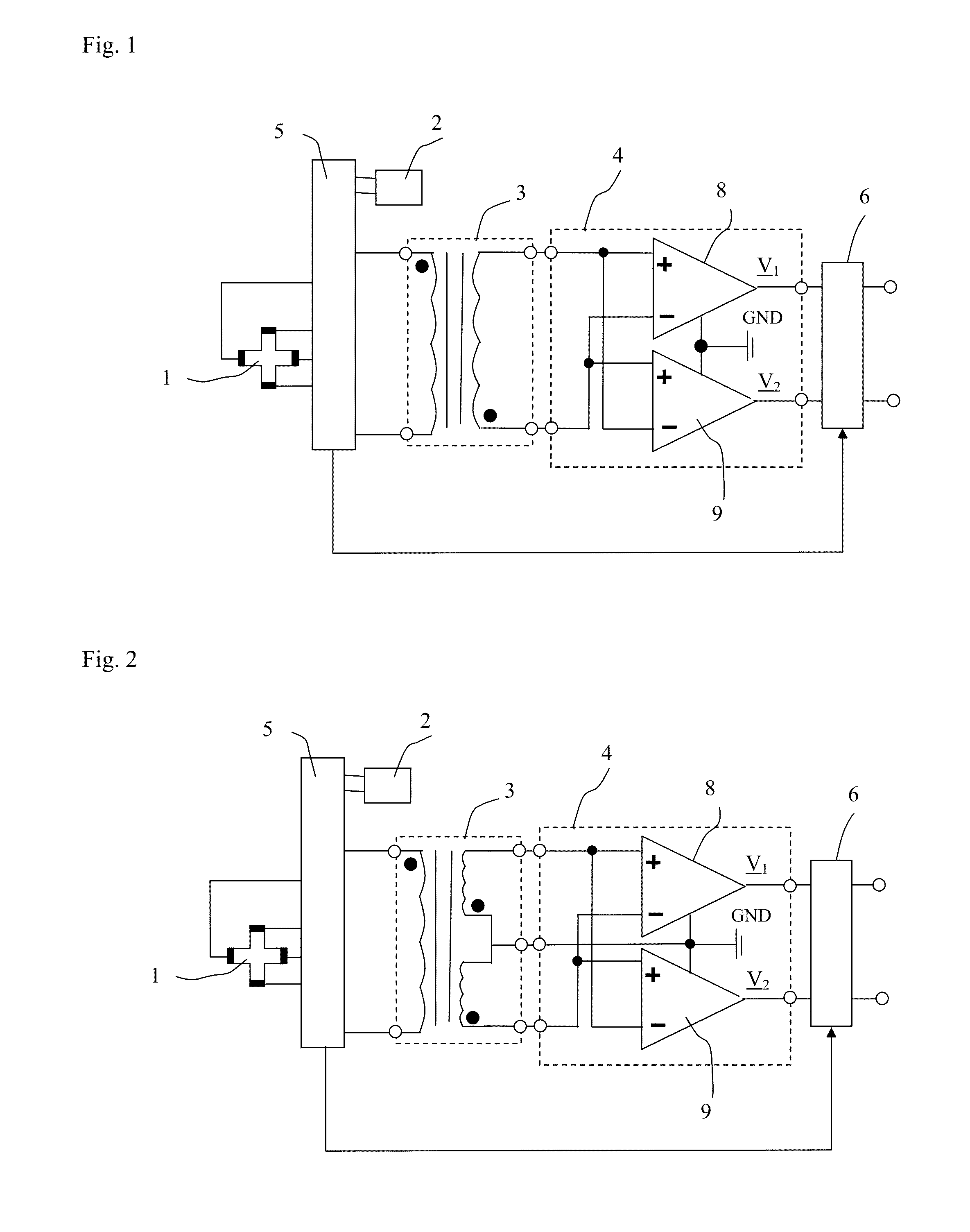Current Transducer For Measuring An Electrical Current
a current transducer and current technology, applied in the direction of short-circuit testing, magnetic measurements, instruments, etc., can solve the problems of machine damage, short-circuit testing, and limited accuracy of clamp-on ammeters, and achieve high immunity
- Summary
- Abstract
- Description
- Claims
- Application Information
AI Technical Summary
Benefits of technology
Problems solved by technology
Method used
Image
Examples
first embodiment
[0076]FIG. 2 shows a first variant of the first embodiment where the transformer 3 has a secondary winding with three output terminals, one of the output terminals being a middle terminal. The middle terminal is coupled to ground GND, either directly or as shown to a ground terminal GND of the preamplifier 4.
[0077]FIG. 3 shows a second variant of the first embodiment where the transformer 3 is composed of two transformers 3a and 3b. The primary windings of the two transformers 3a and 3b are coupled in a parallel manner, the secondary windings are coupled such that two of the four output terminals of the transformers 3a and 3b form a middle terminal. The middle terminal is coupled to ground GND, either directly or as shown to a ground terminal GND of the preamplifier 4.
[0078]In all these embodiments the Hall element 1 is operated according to the spinning current method and it is the logic block 5 that serves for this purpose. The spinning current method consists in coupling the Hall...
fifth embodiment
[0089]Instead of the Hall element(s) or AMR sensor(s), the magnetic transducer may also comprise any other type of magnetoresistive sensors, like e.g. GMR (giant magnetoresistive sensor) sensor(s), or one or more fluxgate sensors. A fluxgate sensor consists of a small, magnetically susceptible core wrapped by two coils of wire. A current source provides an alternating electrical current having a predetermined frequency which is passed through the first coil, driving the core through an alternating cycle of magnetic saturation; i.e., magnetised, unmagnetised, inversely magnetised, unmagnetised, magnetised, and so forth. This constantly changing magnetization induces an electrical voltage in the second coil, the phase of which depends on the external magnetic field to be measured. FIG. 15 shows a diagram of a magnetic transducer according to the invention. In this embodiment, the magnetic transducer comprises two fluxgate sensors 32 and 33. The first coil of the fluxgate sensor 32 is ...
sixth embodiment
[0090]FIG. 16 shows a diagram of a magnetic transducer according to the invention. In this embodiment, the magnetic field sensors are AMR sensors. The AMR sensor 19 is coupled to a first amplification chain comprising the same components as in the previous embodiments and labelled with the literal “a”, the AMR sensor 31 is coupled to a second amplification chain comprising the same components as in the previous embodiments and labelled with the literal “b”. The outputs of the phase sensitive detectors 6a and 6b are coupled to a voltmeter 34 or to an analog to digital converter. However, the transformers may be configured as in any of the previous embodiments. The magnetic field sensors could also be Hall elements or fluxgate sensors in which cases the logic block 5a would have to be modified for Hall elements or fluxgate sensors as shown above.
[0091]In all embodiments with two sensors of any kind, it is preferred to have one transformer having one single magnetic core, two primary w...
PUM
 Login to View More
Login to View More Abstract
Description
Claims
Application Information
 Login to View More
Login to View More - R&D
- Intellectual Property
- Life Sciences
- Materials
- Tech Scout
- Unparalleled Data Quality
- Higher Quality Content
- 60% Fewer Hallucinations
Browse by: Latest US Patents, China's latest patents, Technical Efficacy Thesaurus, Application Domain, Technology Topic, Popular Technical Reports.
© 2025 PatSnap. All rights reserved.Legal|Privacy policy|Modern Slavery Act Transparency Statement|Sitemap|About US| Contact US: help@patsnap.com



